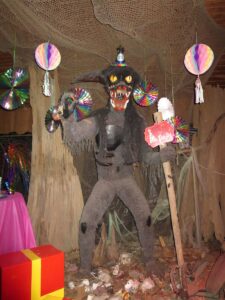Rougarou
The rougarou is one of the most well-known figures in South Louisiana folklore.

Louisiana Endowment for the Humanities
This resident rougarou at the Audubon Zoo in New Orleans, seen here celebrating his birthday, has been terrifying children since the year 2000. Photo by Erin Greenwald.
The rougarou, a phonetic variation from the French loup-garou (for “werewolf”), is one of the most well-known figures in South Louisiana folklore.
Legends of werewolves and lycanthropy have existed throughout Europe for centuries. While “rougarou” is derived from French, the rougarou of Louisiana bears little resemblance to the loup-garou of French folklore. Most accounts or descriptions of the rougarou in Louisiana do not refer to wolves, which is not surprising due to the animal’s scarcity in the region. Stories and accounts of the rougarou are prevalent among Cajun and Houma communities in Lafourche and Terrebonne Parishes.
Legend
In its essence the rougarou is a shape-shifter, half-human and half-beast, typically taking on its monstrous form at night. The rougarou seeks to relieve itself of its curse and regain human form. To do so it must transform a victim by biting them (or otherwise draw blood) and pass the malediction on to the victim, who then becomes a rougarou themself. This scenario is found in other regions of French-speaking North America and is recognized by folklorists as motif D712.4, Disenchantment by drawing blood. If one discovers the identity of a rougarou, it must be kept a secret for either a year and a day or 101 days, otherwise it is believed that one will become a rougarou by revealing the secret too soon.
It may seem paradoxical that few examples of rougarou stories are available in archives and folktale collections despite the creature’s notoriety. What was probably the most extensive set of rougarou accounts collected by Cheryl Cannon was either lost or discarded before researchers could access it. Among the scarce examples available, one finds mostly personal accounts and descriptions of the rougarou’s traits and characteristics. These mostly first-person narratives distinguish the creature from other examples of folklore in the repertoire of shared stories. The rougarou seems more prevalent in literature and popular culture than in field recordings and folklore collections. On the one hand, it is easy to understand its allure as a dark and exotic side of South Louisiana’s bayous and marshes. Another explanation for the legend’s scarcity in archival sources could be that some people are hesitant to share their eyewitness accounts of the creature with outsiders.
“Loup-garou” and “Rougarou”
There has been much discussion around the terms “loup-garou” and “rougarou.” As stated, “loup-garou” is the original form in French designating the werewolf. However, both forms exist in Louisiana and refer to a similar concept. This difference in pronunciation can also be explained. When the two liquid consonants l and r appear near one another in a word, their placement can shift over time, particularly where French is passed down orally. In linguistics this phenomenon is considered rhotacism or assimilation. This same liquid consonant shift can be found elsewhere in Francophone North America, such as in the Laurentides of Quebec and among the Métis in Manitoba. Moreover, this shift is common in other words in Louisiana French (plarine for praline, or garlie for galerie).
Despite the etymology of the rougarou and popular depictions of the creature (by artists who are aware of the term’s etymology), accounts resembling a wolf seem exceedingly rare. The creature is often likened to a dog, while other variants describe something closer to an owl or a more indiscernible form. The disassociation in pronunciation between wolf (loup) and rougarou explains, in part, why the creature is rarely described as a wolf by those who believe they have seen the creature.
Popularity and Cultural Significance
In addition to eyewitness accounts, the rougarou has maintained popularity over time as a kind of boogeyman, similar to other folklore figures in French Louisiana, such as la tataille and Madame Grands Doigts. The rougarou presents an intriguing part of Louisiana folklore because, on the one hand, parents may warn their young children that the rougarou will catch them if they do not behave, respect curfew, or otherwise follow orders. On the other hand, the first-person narratives found in archives and written collections are almost entirely told by adults. For adults, too, the notion of being cursed as a shape-shifter is tied to the punishment for one’s sins, most often failing to fulfill one’s obligations as a parishioner.
While the rougarou remains a well-known cultural and regional symbol in Louisiana, it has also lent itself to appearances in national television series like Cajun Justice and Supernatural. Like most folklore figures the rougarou continues to adapt to a new audience. Rougarou Fest in Houma is a prominent example of the rougarou’s evolution and continued popularity in South Louisiana. Taking place before Halloween, the festival recasts the rougarou as a kind of supernatural protector of the region’s coastal area, benefiting the South Louisiana Wetlands Discovery Center and raising awareness of Louisiana’s rapid land loss due to coastal erosion.
At its core the rougarou offers a unique example of moral ambivalence. In essence, the rougarou is forced into its curse, either by contagion as a victim of another or as punishment for past misdeeds that may have more to do with defying religious expectations or social codes than causing actual harm to others. In this sense, the rougarou of Louisiana is less malevolent than versions of the loup-garou found elsewhere in the French-speaking world or in Europe. In Louisiana there do not seem to be any accounts of the creature killing its victims, and it is not typically described as innately evil. As such the rougarou is a mysterious figure that represents the moral gray area of the human condition that remains a hallmark of Louisiana folklore.
